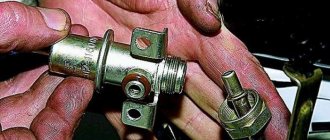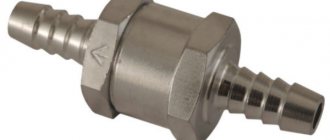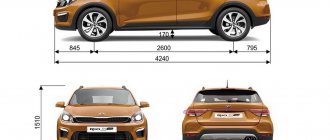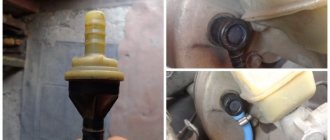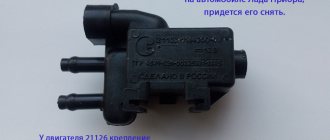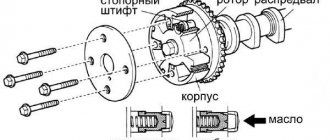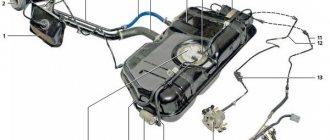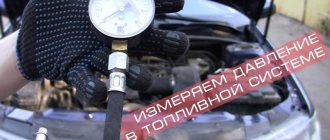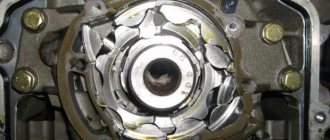One of the most overlooked devices in a car engine is the so-called “check valve”. It is also called a bypass valve or fuel pressure regulator.
How critical is it, does it need to be checked and how often does it need to be done? I must say, it is quite difficult to find a car service that would have equipment for conducting “fuel tests”. As a rule, they do it the old-fashioned way: they pinch the “return” or disconnect it and look at the thickness of the fuel stream from the hose.
The only thing that can be determined by such a “test” is that the fuel pump somehow works. It is, as you understand, impossible to measure the pressure created by the pump using old-fashioned tests. Well, perhaps only in the case when no fuel comes from the return line at all or barely drips.
Where is the fuel check valve located?
Let's find out where the fuel system valve of various cars is located.
- In power plants with an injector, it can be installed in the gasoline pump housing.
- Mounted on the fuel frame or installed directly in the fuel line. This is the space between the gas tank and the fuel injectors.
On diesel power plants, the mechanical structure is hidden between the fuel injection pump and the low-pressure pump. This arrangement of the product allows you to create a stable pressure at the outlet of the high-pressure pump.
The system has proven itself well:
- on a domestic truck: KAMAZ 740;
- Czech clubfoot Tatra;
- on Mana;
- and Renault Magnum.
In diesel installations where a pre-start heating system is provided, the fuel check valve is located in front of the heating system. A typical example is the same KamAZ or Magirus trucks operating in the Far North.
On domestic passenger cars, such as the VAZ 2110 and 2114 with sixteen valves, the mechanical structure is located in the gasoline pump and on the fuel frame. This is analogous to installing a diesel engine.
Today, old carburetor cars with front-wheel drive still run on our roads: eights and nines (VAZ 2108 and VAZ 2109). On them, the role of the return device is assigned directly to the gasoline pump.
It stands on the cylinder block and prevents the passage of fuel in the opposite direction: into the fuel tank.
The fuel supply system of automobile gasoline and diesel power units is a technically complex device that should not be approached without knowledge. And even more so, try to carry out technical treatment on your own.
The check valve plays an important role in the regular supply of fuel. Let's focus our attention on its design and installation in the car. Let's look at the problems and characteristic signs of a malfunction. We will also decide on ways to check it.
conclusions
The fuel system check valve is an important component of this system, the failure of which can cause a lot of problems for the driver. This will be especially painful during movement. Therefore, it is worth using only high-quality fuel, and at the slightest sign of a malfunction, which were listed above, diagnosing the fuel system.
After all, the problem may lie not only in the valve, but also in other small parts. Diagnostics at a service station almost always reveals such faults, so do not forget about timely maintenance of the car, even if everything seems to be in good order.
Tiptronic automatic transmission - what is it and why is it needed?
Battery with AGM technology - what is it and how does it work?
How does the EBD system work in a car?
Reference
Many people know that the fuel system valve aggregates:
- With carburetor power units running on gasoline.
- With engines equipped with an injector.
- With power supply systems for power plants, where diesel fuel is used as fuel.
There is nothing complicated about the mechanical design. This is a ball-type device with a seat, which is made of soft metal, with the most accurate balancing. Fuel flows freely through the fuel valve in one direction. The pressure that is created prevents gasoline or diesel fuel from flowing back into the fuel tank, since the non-demountable structure is locked.
Despite its simplicity, the device can cause a lot of trouble for a novice and an experienced driver. Therefore, it is necessary to know its possible vagaries and ways to eliminate breakdowns. But first of all, understand where the mechanical structure is installed.
“The concept of a fuel system check valve should not be confused with a pressure reducing device.”
Installing additional OK
It is recommended as an option for upgrading a system in which the original valve no longer holds (or does not exist at all). You just need to try to choose a high-quality valve, and the cross-sectional dimensions must be suitable. For example, some models of VAZ valves are not suitable for foreign cars. You can install them, but they don't last long. As soon as you accelerate sharply or climb a mountain, the valve slips and the car begins to choke.
It would be better to buy OK from parsing. Find the fuel pump of a specific car model, check the valve, if it works, take it. It does not matter whether the pump itself is running or not. The main thing is to hold the valve.
Fuel system check valve Nexia
All that remains is to embed the valve into the line, in any convenient place. For example, between the fuel pump and the filter. Then check on a hill or when accelerating to see if the car is choking.
Source
Draw your attention to.
If the fuel check valve loses its seal, gasoline flows back into the tank without permission. In this case, starting the power unit is possible with manual pumping.
If starting the engine was difficult, craftsmen installed (embedded) a mechanical structure into the power system, closer to the carburetor.
This made it possible to easily start the engine even at negative t0. An example is the old Opel (Cadet) and 323 Mazda, which have seen time in their lives.
What causes breakdowns
Often the check valve of the VAZ fuel system fails. The reason for this may be the use of defective or low-quality parts. Therefore, you should be careful when purchasing spare parts from unverified stores. There are also defects in factory parts of domestic budget cars.
Most often, failure occurs due to natural wear and tear during long-term use. It is mainly the spring and the diaphragm that become unusable; cases of complete valve failure are extremely rare.
Low quality fuel can also cause breakdowns. After refueling with gasoline mixed with water, moisture ends up in the regulator. Dirt may also get into it due to untimely replacement of the fuel filter.
Check valve problems
For what reason does the fuel system valve fail? Let's figure it out together. Today there are three obvious reasons for refusal to work.
- Installation of low-quality Chinese goods that quickly fail. Basically, these are fakes for a certain brand.
- The second reason is the natural wear and tear of the product. In this case, either the spring or the membrane fails. Note that the valve itself rarely fails.
- Another problem for a non-removable mechanical structure is low-quality fuel.
Having decided on possible problems, let's move on to the signs indicating a problem.
Checking the fuel pump of a carburetor car (mechanical)
Mechanical fuel pump - diagram
To check the functionality of the fuel pump, you need to:
- Remove the fuel line from the carburetor inlet.
- Immerse the tube in a specially prepared transparent bottle, manually operating the pumping lever, you will notice how strong and dense the stream is supplied with fuel. Air pollution should not be visible visually.
A jet being late is not a sign of a breakdown, especially if the car has been parked for a long time. Usually the main cause of failure is diaphragms eight and nine.
However, both the filter and the inlet/outlet valve need to be checked.
Even when replacing the seals, fuel leakage may occur. In this case, the problem is the tightness of the fuel pump housing due to deformation during repairs.
Let's summarize:
There are many causes for both electrical and mechanical fuel pump failures, and having to find/repair the problem can take you by surprise. By following the above recommendations, you can independently carry out all the necessary measures to diagnose this device. And you should start with the power source (if it is an injection pump) and the operation of the membrane when checking a mechanical type injection pump. Most often, unstable operation of the fuel pump is not due to its failure, but to related parts - filter, check valve or injectors.
Characteristic symptoms of a check valve malfunction
It could be:
- unexpected change in speed of the power unit at startup or while driving;
- The engine can be started by pressing the accelerator pedal. Although before this the power unit was driven by a starter;
- Unstable engine operation at low or idle speeds;
- loss of fuel that escapes through the supply or return pipes. In this case, the sealing of the fuel hoses is not broken.
In our case, the non-removable mechanical structure can be easily repaired. This is on the one hand. On the other hand, the problem cannot be determined by scanning. Next, let's look at options for checking the device.
Location
The OK can be installed in different places: in the fuel pump housing, on the ramp, or simply between the tank and the injectors. The exact location depends on the specific car model.
For example, on most diesel cars the OK is placed between the low-pressure pumping device and the injection pump. Here, in addition to its main functions, it is responsible for the stability of the pressure at the injection pump inlet. Examples: KAMAZ, Tatra, Man trucks, etc.
Article on the topic: Varta battery
Where is the fuel system check valve located?
But in KamAZ vehicles intended for operation in arctic conditions, in Magirus truck systems, a check valve is installed in front of the heating system.
On VAZs with injectors equipped with 16-valve engines, the OK is installed either in the fuel pump or on the ramp. But in carburetor VAZs of the old type, on the “classics”, it is not there. But the function is provided. The role of OK is played by the fuel pump itself, installed on the BC.
How can you check a check valve?
You can find out what condition the fuel valve is in as follows.
Using a pressure gauge, check the pressure. It should be within 3 kg per cm2. These are figures for passenger cars.
You can find out how the device works by pinching the “return” fuel hoses. If the permanent mechanical structure is in order, the pressure should increase.
For your information.
This method is only for cars that have rubber hoses installed.
Self-diagnosis can be carried out without using a pressure gauge. This concerns the problem of unstable operation of the internal combustion engine (ICE) and poor acceleration. Having pinched the rubber hose that moves the fuel in the opposite direction, you need to pay attention to the operation of the engine. If the speed increases and the engine cylinders operate as planned, then the check valve is faulty.
FakeHeader
Comments 66
Pump replacement. The pump has its own valve.
the valve should fall apart from the inside about the quality of the parts. There are valves in the fuel pump that are supposed to keep you on track. your pump is probably already pumping poorly or you need to change the fuel injection pump or the valve inside (repair kit and, again, it’s not a fact that the quality will be). I replaced the diaphragm in mine, but did not change the valve, although on the Internet they do not hold up well, many people complain about the repair.
in general, you have the following options: 1 make an attachment for manual pumping and manual pumping (the same rope) from waste 2 valve replacements (high-quality) up to 500 rubles 3. Replacement of the injection pump (again high-quality) 1000-2000 rubles 4 switch to electro. 5 is not a standard version in the form of a check valve (high quality).
in option 5, you need to find a specific check valve for the gas line; you should also take into account that the pressure in the gas line is low.
In addition to the electric pump. The trick is that it doesn't require valves. Even though all the fuel in the carburetor had evaporated, I turned on the ignition, waited a couple of three seconds while the EBN primed the carburetor and started.
1200 rubles for a photo report
We pay for photo reports on car repairs. Earnings from 10,000 rubles. / Month Write:
The reasons why fuel pumps fail are not always the same, and the devices themselves can be electrical or mechanical. Diagnostics of the performance of these types is different, so we will consider ways to separately check the operation of fuel pumps. However, the operation of the fuel pump can be checked in 7 steps.
The need to check the fuel injection pump appears when the following signs of malfunction occur:
- the engine stopped;
- the car moves chaotically, jerkily;
- the engine idles unstable and does not start;
- there are “floating” turns;
- increased noise, whistling when the car is moving.
Lada Priora Hatchback ✤ℨℰȴеℋÅЯ МОШℵИЯ!!! › Logbook › The main thing about the pressure in the fuel system.
Fuel pressure in the car system is one of the important parameters that is used in engine diagnostics. The behavior of the car in various operating modes depends on the pressure. How to measure the pressure in the fuel system with your own hands
For example, buy a device to check fuel pressure. A kit with a fuel pressure gauge, adapter and drain will cost you 1400-1500 rubles. Pay 300-400 rubles to the service station and take measurements there. You can also measure the pressure in the fuel system with an air pressure gauge, which is used to measure tire pressure. Here at this point in more detail. Let's take the example of the tenth VAZ 2110 family. Otherwise, the procedure is similar to any other car. The peculiarity of pressure gauges is that their initial scale values have relative inaccuracy. What does it mean. If the air pressure gauge has a scale of up to 16-20 atm (when the measurement limit for fuel is 5-7 atm), then pressure measurements will not be accurate due to this error, which will fall within the initial values of the instrument scale. Therefore, it is correct to check the fuel pressure with a fuel pressure gauge with a limit of 6-7 atm.
We take a pressure gauge and wrap a piece of foam (plumbing flax) under the pipe and put on an oxygen hose with an internal diameter of 9 mm. Secure with clamps. Place a rag on the generator (so as not to start a fire under the hood). Unscrew the plastic cap on the fuel rail.
put the hose on the pressure gauge
Under the cap there is a hole with a nipple. Unscrew it from the wheel cap. Due to the residual pressure in the rail after removing the nipple, gasoline will splash out.
If desired, you can relieve the pressure in the vehicle's fuel system. To do this, you need to remove the fuel pump fuse and wait until the running car stalls.
We put the second end of the hose on the ramp hole and secure it with a clamp. We remove the rag from the generator and start the engine. Don’t forget to cover the generator with a rag again before removing the hose from the ramp. That's it, now you know how to check the pressure in the fuel system in the field.
attach the hose with pressure gauge to the fitting
check the fuel pressure in the system
By the way, instead of clamps, you can use the classic adjusting bolt bushing. It screws perfectly onto the ramp fitting. To seal, we put a suitable rubber ring on the fitting. On the other side of the bushing we solder a fitting onto which we put a hose with a pressure gauge.
What pressure should be in the VAZ 2110 fuel system? 2.8–3.2 bar (2.8–3.2 atm)
How to measure fuel pressure in a system where there is no return? On VAZ 2110 with 1.6 liter engines, the pressure in the ramp is constant and amounts to 3.6-4.0 atm. Otherwise, the measurement technique is similar. Alternative ways:
It is measured at the outlet fitting of the fuel pump module - this is the one with one tube. You will need a flexible gas-resistant hose with an internal diameter of about 8 mm and a pressure gauge (you need to remove the tube and put on a hose with a pressure gauge instead). The pressure should be 5-7 atm. Close the return line, as is done on an internal combustion engine with a drain ramp, but you must turn it off again at the fuel pump itself. We pull off the second hose (double) and insert a plug into the removed hose, made, for example, from an old fuel filter (saw off the nipple from it and plug it). A single hose must be put on the pump fitting, and now the measurement must be made at the fuel rail. According to the power system diagram, everything will be clear.
Work order
- First, disconnect the negative terminal from the battery (key to “10”).
- Disconnect the regulator vacuum hose from the intake manifold fitting.
- Using a “17” wrench, unscrew the nut securing the drain hose. Disconnect the hose.
- Using a Phillips screwdriver, unscrew the bolt of the return pipeline clamping plate.
- Using a hex wrench set to “5”, unscrew the screws securing the RTD to the fuel rail.
- Using a “24” wrench, unscrew the nut connecting the drain hose fitting and the RTD.
- Remove the fuel pressure regulator.
That's basically the whole process. Installation of the RTD is carried out in the reverse order
Important: do not lose the rubber seal that comes with the regulator. Without it, the connection between the RTD and the fuel rail will be leaky, which will lead to a change in the operating pressure in the system
Device and principle of operation
The check valve device is simple. The entire mechanism consists of a spring, a membrane and the valve itself. The ball-type valve is equipped with a special seat, which is made of soft metal and is calibrated as accurately as possible.
The valve body is equipped with three outlets: the first is for the intake manifold, and the others are for fuel removal. Fuel moves freely through the valve in only one direction.
It is not able to flow back into the valve due to the pressure created on it, which is why it closes. The valve opens due to the movement of the spring resulting from the vacuum as the engine speed increases. Excess fuel is returned back to the fuel tank.
The check valve for diesel fuel is no different in operating principle from its “brother” used in gasoline engines; differences can only arise in the location of this unit.
Diagnostics
If you notice characteristic signs, you should first make sure that the problem lies in the sensor. To do this you will need to do the following:
- unscrew the fitting plug, which is located on the end of the ramp block and performs the functions of monitoring the fuel pressure;
- there is a special ring at the bottom of the plug that compensates for distances - inspect it carefully;
- if the ring is damaged, has flaws, or has become less elastic, be sure to replace it with a new one;
- then, using the tire cap, unscrew the spool located in the middle of the fitting;
- Using a tire pressure gauge, which is usually used to inflate wheels, measure the pressure when the power unit is operating. Compare the resulting value with the one recommended by the car manufacturer. As a rule, it should not exceed 3.3 units.
Basically, when the vacuum hose of the sensor is disconnected, the pressure begins to increase.
If it remains at the same level, it means that the fuel pressure sensor in the VAZ 2110 ramp is definitely broken and requires replacement.
In the future, it is recommended to regularly inspect the RTD. If, after replacing a part, fuel consumption still remains high, the replacement may have been carried out incorrectly and should be carried out more carefully.
How to troubleshoot the VAZ 2110 fuel pressure regulator?
Replacing the fuel pressure regulator yourself on a car like a VAZ 2110 should not cause any special problems.
Even a beginner can cope with the task, so there is no need to immediately seek help from specialists at a service station and pay them a fairly large sum of money. In addition, not every car service center will do quality repairs.
In any case, any owner of the VAZ 2110 model should know exactly how to replace the fuel regulator.
You will need to complete the following steps:
- reduce the pressure in the fuel system;
- Unscrew the bolt that secures the fuel pipe to the fuel sensor;
- using a 10mm wrench, remove the fastening to the oil level indicator guide tube and remove the tube;
- Unscrew the 2 nuts securing the sensor to the injector ramp;
- remove the sensor fitting from the ramp;
- remove the gasoline hose from the RTD;
- remove the broken fuel pressure regulator;
- install a new sensor together with it.
When installing a new pressure sensor, the old cuffs should be replaced, since they mostly lose their original qualities. You can also try soaking them in gasoline, but most likely this will not help them work as before.
So, the fuel pressure regulator is one of the main components of the VAZ 2110 car, as well as any other car
It is responsible for the normal operation of the entire fuel system, which is why it is so important to constantly monitor its condition and, if characteristic signs of failure are detected, immediately replace it with a new sensor or eliminate existing defects
The principle of operation of the main elements of the fuel unit
What is the valve in the oil filter for?
Video Replacing the cabin air filter on a VAZ 2114 VAZ 2115 VAZ 2113 Lada Samara 2
Fuel system VAZ 2114
Container for storing flammable materials
It is made of steel, consists of two firmly welded parts, the neck through which the fuel enters is connected to the tank with a rubber pipe and secured with clamps.
Gasoline pump
This tool with an electric mechanism is located in a tank with a fuel mixture level indicator. Its actions are coordinated by the engine control box, through a special pump relay, which supplies fuel through the line to the injectors. At idle or when the engine is completely turned off, the pressure is maintained due to the action of a one-way lock, which is located near the unit itself.
The VAZ 2114 power system has a fuel pressure regulator and injectors. The voltage is supplied to them from the battery through the main relay. Thus, the amount of driving fluid is indicated by the duration of the pulses, which are generated by the engine control unit and transmitted to the injectors.
Ramp
Located on the intake manifold, it includes a fuel control element and a pressure valve with a spring-loaded diaphragm. It, in turn, divides the regulator body into 2 parts: the fuel part regulates the pressure of the combustible mixture, the air part, due to the rarefaction of the air, raises the membrane and produces constant fuel pressure readings in the rail.
When the engine starts, the vacuum behind the damper decreases, the diaphragm closes the power system valve, so the pressure increases. When the vacuum is maximum, then the fuel pressure decreases. The regulator is not dismountable, so if it fails, it is replaced with another one.
Fuel mixture control sensor
The pump module has a float, which is located in the tank cavity. When the position of the float changes, the resistance of the unit changes proportionally. According to a certain signal, the fuel quantity indicator on the dashboard displays the presence of fuel in the system.
Why does the sensor often fail?
- fragility of the case;
- frequent temperature changes;
- condensation formation in the tank;
- when using a low-quality combustible mixture;
- oxidation of contacts when sealing is broken.
That is why it is so important to carry out preventive maintenance on time, clean the unit, change contacts in order to prevent its destruction. Changing a device is not that easy. Many markings are original and unique, which means that the services of professionals will be required, which are also not cheap
Many markings are original and unique, which means that the services of professionals will be required, which are also not cheap.
Hoses and pipelines
Such irreplaceable products guarantee uninterrupted circulation of flammable liquid from the container to the main line and nozzles, and if there is excess, they transfer the residual liquid back to the tank. The pipelines are located on the bottom of the vehicle, they need to be carefully checked, cleaned, inspected for integrity, various deformations identified and promptly eliminated in order to avoid fuel leakage, as well as poor transmission to the injectors.
Another function of the pipelines is the transfer of fuel vapor from the tank to the activated carbon section, where waste is collected when the engine is turned off. After it is started, the electromagnetic device is triggered and the vapors escape into the engine, where they are destroyed.
Highway
The design of the VAZ 2114 fuel system includes a main line that guarantees the supply of fuel to all injectors. Today, the fuel pressure regulator is placed in the tank and is not located on the line; there is also a service valve, which performs the function of eliminating air after a technical inspection of the vehicle.
The fuel injection system of the VAZ 2114 includes an uninterrupted mode for collecting fuel vapors, and the gravitational unit located in the device helps prevent fuel from leaking when the vehicle is in an emergency position.
When the engine's air consumption is high, the system is purged more intensively. The filter element is made of durable paper material, after which the air moves through the mass air flow sensor and moves into the intake hose, which leads to the throttle assembly.
Thus, the operation of the fuel fluid supply mode of an engine with a fuel injection system on a VAZ 2114 car occurs.
